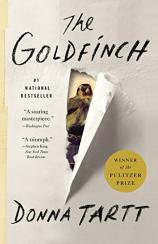The Goldfinch
Review
The Goldfinch
If you’re looking for a tried-and-true literary device with which to start an action-packed novel, the stolen painting is a good candidate. In last year’s THE ART FORGER, B.A. Shapiro crafted an entertaining tale out of an artist’s attempts to paint copies of a work pinched from Boston’s Isabella Stewart Gardner Museum. Now, in THE GOLDFINCH, Donna Tartt’s 800-page novel, a masterwork taken from New York’s Metropolitan Museum of Art after a terrorist attack is the catalyst for an overwritten but inventive story that includes bipolar Wall Street executives, Ukrainian druggies with ties to criminal elements, and failed actors contriving equally doomed careers as Vegas gamblers.
The protagonist is 13-year-old Theo Decker, a Manhattan student who has been suspended from school for smoking. Theo and his mother, Audrey, are on their way to a meeting at school. Audrey has an art history degree from NYU and supervises photo shoots for an ad agency. Theo’s father, a former actor, abandoned the family a year earlier. Audrey and Theo are early for the meeting, so they stop at the Met to see an exhibit of Dutch paintings, “Portraiture and Nature Morte: Northern Masterworks of the Golden Age.”
"Tartt’s strength is plot. She has created many well-drawn characters and clever twists... [G]ive Tartt credit for daring to write a book that is so brazenly different from many other modern novels."
While they are in the museum, a terrorist bomb explodes. Dozens are killed, including Audrey, who is struck in the head by flying debris from the gift shop, where the bomb was planted. Theo survives. When he comes to, he finds lying next to him a dying old man coated in ash. The bleeding stranger babbles to Theo about Mozart and France and piano lessons. He implores Theo to take from the rubble a small painting of a goldfinch, a 1654 work by the Dutch painter Carel Fabritius. Then he removes a gold ring from his finger and presses it into Theo’s palm. “Hobart and Blackwell,” the man says. “Ring the green bell.”
Theo moves in temporarily with the Barbours, a wealthy family whose younger son, Andy, is one of his closest friends at school. Shortly after the move, Theo looks up Hobart and Blackwell in the phone book and discovers that it is the name of a business in the West Village. When he visits the building, he sees that it is an antiques shop, with trinkets such as Staffordshire dogs and “settees upholstered in sallow old brocade” in its dusty windows. A tall, haggard-looking man answers the door. After Theo gives him the ring, the stunned man introduces himself as Hobie and invites Theo in.
What follows is an intricately plotted adventure that, over 14 years, takes Theo from Hobie’s old curiosity shop to the desert of Las Vegas and the streets of Amsterdam. The one constant throughout these adventures is the stolen painting, which Theo has hidden in a pillowcase. No one, not even the authorities, knows he has it.
Read a review of THE GOLDFINCH, including this one, and you’re bound to see the word Dickensian. Tartt encourages the comparison: Hobie refers to Ebenezer Scrooge and the Artful Dodger; characters have names like Bracegirdle and Havistock Irving; a major character becomes an orphan. And the novel, like Dickens’s best works, is huge.
THE GOLDFINCH possesses the good and bad qualities of Dickens’s output. Tartt’s novel, like much of the Dickens canon, would have benefited from more rigorous editing. Tartt rarely passes up an opportunity to give us five or six details when one or none would have sufficed. She tells us the names and titles of five administrators whose offices Theo passes as he escapes the bombed-out museum. We learn the names of five of Andy’s AP classes, the titles of the Graham Greene films he watches one night, the menu items at a Las Vegas restaurant. The lawyer Bracegirdle begins a conversation with Theo by reciting a page-long backstory of the circumstances whereby he met Theo’s mother. Parenthetical digressions abound.
However, the novel entertains despite its excesses. Tartt’s strength is plot. She has created many well-drawn characters and clever twists, although some of the latter depend on coincidences and chance meetings in a city of eight million. THE GOLDFINCH is far from perfect, but give Tartt credit for daring to write a book that is so brazenly different from many other modern novels.
Reviewed by Michael Magras on October 25, 2013
The Goldfinch
- Publication Date: April 7, 2015
- Genres: Fiction
- Paperback: 784 pages
- Publisher: Back Bay Books
- ISBN-10: 0316055441
- ISBN-13: 9780316055444





